
40 Years in America

|
|
40 Years in America |
|
The Danbury Course
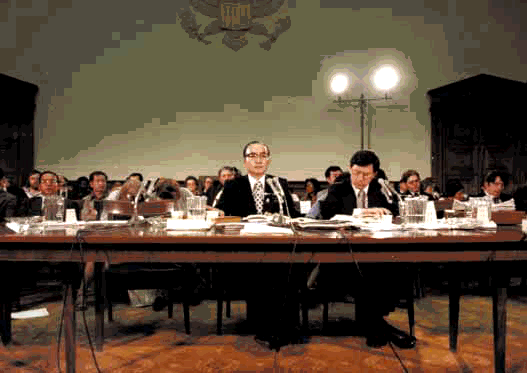
Dr. Bo Hi Pak testifies before the U.S. House Subcommittee on International Organizations.
Despite its legal gains, the church lost the one case that was the most highly publicized, most costly and that mattered to it the most. The indictment, prosecution, conviction and imprisonment of Rev. Moon on tax evasion charges had an air of inevitability about it. Tax convictions have been a time-honored way of rooting out undesirables and although the review process makes it more difficult within the American system, there still has been a tendency "to go after unpopular, but not necessarily criminal figures who can only be tripped up on tax evasion charges." The odd thing about Rev. Moon’s case was that it continued to move forward in the face of so many obstacles. First, the audit of Rev. Moon’s tax returns for the years 1973-75 showed a total liability of $7,300, less than the $2,500 per year required by IRS guidelines for criminal prosecution.
Second, three career attorneys from the Criminal section of the U.S. Department of Justice’s Tax Division questioned whether there was any liability at all and unanimously concluded in a written memorandum that prosecution was not advisable. In fact, according to one account, the Department’s chief of criminal tax prosecution warned that because Rev. Moon’s tax returns did not claim a large charitable contribution, "the government might find itself in the embarrassing position of owing him a tax refund." Third, the prosecuting attorney had to convene three grand juries before getting the necessary indictments.
Fourth, a mostly unlettered jury had to sift through hundreds of prosecution tax exhibits and technical argumentation that, in the opinion of the trial judge, were glazing over the eyes of even trained legal observers. Fifth, the U.S. Solicitor General and the Supreme Court had to ignore briefs from most of the country’s mainstream religious groups that maintained in holding funds for the church in his name, Rev. Moon had no tax liability and exercised an accepted and widely practiced trustee role known as corporation sole.
However, for the church, especially in retrospect, Rev. Moon’s tax case was not about legal niceties. Rev. Moon’s previous trials and imprisonments, both in North and South Korea, were part of the church’s lore and hymnody. To be sure, there were vast differences in time, place and circumstance between what already had been memorialized and what in America was being experienced first-hand. In particular, followers had far more resources with which to mount a defense than they possessed in the late 1940s or mid-1950s. Nevertheless, the outcome was the same. This stimulated a variety of theological constructions. Members utilized terms such as "sacrifice" and "crucifixion" to describe the course of events. Some interpreted the situation in ways that resembled ransom theories of atonement. Though "completely innocent," Rev. Moon made "an offering of himself for America and the world, for Christianity and all religions" was how one major church leader described the scenario. Others understood that he offered himself in a substitutionary way for the Unification Church that had failed repeatedly to win an adequate following or exert substantial influence in America.
Although these interpretations were mostly in-house and would not have won ready assent from the public, they did accord in general terms with the flow of events. Despite the fact that there was no extradition agreement between the United States and the Republic of Korea, Rev. Moon did elect to return voluntarily to face his accusers. Doing so involved a good deal of public humiliation and suffering. He attended court sessions every day during the six-week trial and during the appeal process, his seventeen-year-sold son, Heung Jin, who was highly regarded within the church, died in an automobile accident.
During his thirteen-month imprisonment, Rev. Moon performed a variety of menial tasks at Danbury, Connecticut Correctional Institution. At the same time, while under indictment, in trial, during the appeal process and in prison, he initiated a number of important projects directly relevant to the movement’s ministry, including two massive marriage blessings, the Youth Seminar on World Religions, The Washington Times, CAUSA-USA, and several ministerial outreach programs which included a donation of 250 large trucks to the National Council for the Church and Social Action. Finally, as has been noted, Rev. Moon’s prosecution and jailing gained the church a significant amount of grassroots support. Taken together, the investigations leading to his indictment, the trial and appeal process, and his imprisonment constitute what can be termed "the Danbury course." More than any other sequence of events, it was the fulcrum around which the history of the Unification Church in America turned.
Two important congressional investigations helped instigate Rev. Moon’s indictment on tax evasion charges. One was that of the U.S. House Subcommittee on International Organizations, chaired by Rep. Donald Fraser (D-Minnesota). Its probe into Korean-American Relations and, in particular, into the activities of the Korean Central Intelligence Agency (KCIA) in the United States was described earlier as an ominous development in 1976. The Subcommittee and the church had an adversarial relationship from the beginning of the investigation, and several members declined to answer questions or cooperate due to what they regarded as the Subcommittee’s intrusions into church matters and breaches of confidentiality. In early 1977, the Subcommittee gained additional funding and intensified its investigation in the wake of Korean influence-buying on Capitol Hill, which in the idiom of the time was known as Korea-gate. In its determined effort to establish links between the KCIA and the church, the Subcommittee leaked several confidential, unevaluated intelligence documents which led to press reports that the church "was founded by the Director of the Korean Central Intelligence Agency...as a political tool in 1961" or, alternatively, that it had emerged "from its origins as a small-time Korean sex cult to a worldwide organization operated by the Korean Central Intelligence Agency." Both of these allegations were patently false, as the Subcommittee’s final report indicated.
The Subcommittee subpoenaed Col. Bo Hi Pak for testimony on several occasions but may have not been entirely prepared for his responses. In his initial appearance, Col. Pak complained bitterly that the Subcommittee was "ostensibly pursuing a probe of the KCIA" but had "given the impression to the world through the press that the United States Congress is investigating the Unification Church of Reverend Sun Myung Moon." In his second appearance, Col. Pak escalated his rhetoric, stating his belief that the Chairman was "being used as an instrument of the devil." He continued,
I know it is easy and popular in the short run to persecute new religious groups. So it was for Nero. So it was for Julian the Apostate. But does history remember them for their social reforms or foreign policy or human rights? No! It remembers them as the great persecutors in history. And so history might remember Donald Fraser, if it remembers him at all. You may get my scalp, Mr. Chairman, but never my heart and soul. My heart and soul belong to God.
In his third appearance, Col. Pak charged that the Subcommittee had "secretly determined to destroy one man...Reverend Sun Myung Moon, and his movement." He also detailed the Chairman’s "operational ties" to communist organizations and cited the testimony under oath by a former Polish intelligence official that Congressman Fraser was "an agent of influence on the Hill for the Soviet Union."
All of this was great theatre, and, in fact, the movement circulated a documentary version of Col. Pak’s testimony, entitled Truth Is My Sword. However, it did not materially affect the subcommittee’s final recommendation that "The Department of Justice, the SEC, the IRS, and other executive branch agencies currently investigating allegations relating to Sun Myung Moon, Pak Bo Hi, the UC...and other individuals and organizations comprising the Moon Organization...should coordinate their efforts and create an interagency task force." The movement’s response noted that having spent $685,000 in an eighteen month investigation with thirteen full-time staff employees only to conclude that the "Moon Organization was not an agent of influence for the ROK Government," the Subcommittee "now called on the federal government to form an ‘interagency task force’ and find some charge, any charge, on which the Church or its members can be found guilty." No interagency task force was created, and Congressman Fraser lost in his bid to gain a seat in the U.S. Senate. Nevertheless, his Subcommittee helped perpetuate a climate of suspicion and hostility in relation to Rev. Moon and the Unification Church.
The other congressional investigation consisted of two unofficial meetings convened by Senator Robert Dole (R-Kansas). The first, a February 18, 1976 "Day of Affirmation and Protest," was previously discussed. It afforded antichurch activists the opportunity to present their grievances to representatives of seven U.S. government agencies. The second, which followed on the heels of the Jonestown tragedy in Guyana, was a one-afternoon information session for members of Congress on "The Cult Phenomenon in America" sponsored by Senator Dole on February 5, 1979. The first of these "unofficial" inquiries was the most consequential in launching the IRS investigation that eventually led to the indictment of Rev. Moon. This was because on January 6, 1976, prior to the Day of Affirmation and Protest, Senator Dole wrote a letter to the IRS commissioner stating that an audit of the Unification Church "may be warranted" and requested his response. While it was not unusual for members of Congress to write letters to officials in the executive branch, Dole’s letter carried extra weight, as he was a ranking member of the Senate Finance Committee, which had direct control over the IRS budget. Three days after sending the letter, Senator Dole and his staff added more pressure by issuing a press release highlighting the note’s content. The Day of Affirmation and Protest provided further notice that "he was serious about what he said to the IRS."
Within days, the IRS began what Carleton Sherwood, in Inquisition, The Persecution and Prosecution of the Reverend Sun Myung Moon (Regnery Gateway, 1991) termed "the most intensive and expensive criminal tax investigation of any religious figure in U.S. history." According to Sherwood, "Within five months of the Dole non-hearings, a squad of IRS agents had taken up permanent offices in the Unification Church’s downtown New York headquarters, while a team of field agents began round-the-clock surveillance of selected church members and their telephones." In 1978, after two years of investigations, the IRS was unable to find anything that compromised the church’s tax exempt status but turned over to the New York District Attorney’s Office "certain anomalies" in Rev. Moon’s tax returns for the years 1973-75. At issue were two sets of assets openly held in Rev. Moon’s name: 1) accounts totaling $1.6 million at the Chase Manhattan Bank; and 2) $50,000 worth of stock in Tong Il Enterprises, Inc. The government contended that Rev. Moon owned these assets beneficially and therefore owed taxes on the bank interest and stock value. The church held that Rev. Moon held these assets as a trustee for the followers of the Unification faith and therefore owed no such taxes.
The Office of the U.S. Attorney for the Southern District of New York pursued the matter aggressively but, despite convening three grand juries, was having trouble getting an indictment. Also, as already noted, career attorneys from the Criminal Section of the U.S. Department of Justice’s Tax Division did not deem Rev. Moon’s alleged tax liability sufficient to warrant prosecution and signed off on a triple negative recommendation. However, in August 1981, the New York District Attorney’s Office presented new charges of perjury, conspiracy and obstruction of justice that reopened the case and led to Rev. Moon’s indictment. These charges stemmed from two sources: a "Japanese Family Fund Ledger" and promissory notes submitted by the defense to account for the sources of funds in the Chase Manhattan account; and the grand jury testimony of Takeru Kamiyama, who was understood to be Rev. Moon’s financial advisor. The government claimed that the Japanese Family Fund Ledger, which listed dates and amounts of contributions from Japanese Church members between June 1972 and March 1976, as well as loan agreements reflecting transfers of funds from foreign church members to be deposited into the Chase accounts were prepared after the IRS had begun to investigate Rev. Moon’s tax returns and were "phony." It claimed that Mr. Kamiyama had lied to the grand jury.
This alleged "cover-up" was the "bridge" that led to the trial and conviction of Rev. Moon. However, Rev. Moon’s defense team and a number of later observers questioned the sturdiness of that bridge. First, as the brief for Rev. Moon to the Court of Appeals noted, "The record is barren of any evidence whatsoever that Reverend Moon was involved in or consulted about the preparation of any of these...documents." Second, the church and its defense lawyers acknowledged from the beginning, both in conferences and sworn testimony, that the Family Fund Ledger and promissory notes were good faith efforts to reconstruct "actual prior transactions." Third, and most important, the perjury specifications against Mr. Kamiyama were seriously flawed. The most egregious problems were the errors in translation by the grand jury interpreter. An analysis of the transcript "found over 600 translation errors, more than 75 of which materially affected...perjury charges" brought against Mr. Kamiyama.
There was even a serious question as to whether Mr. Kamiyama ever testified under a valid oath, as the translator "was entirely ignorant of the basic word perjury, and never properly warned the witness about the sanctions against lying under oath." He also hopelessly botched the oath’s translation. The errors were so grievous that after reviewing the case three years later, the U.S. Senate, under bipartisan sponsorship, passed the "Court Interpreters Improvement Act of 1985" which extended standards established previously for courtrooms to grand jury proceedings. What was worse in Mr. Kamiyama’s case, according to Carleton Sherwood, was that the prosecuting attorney had obtained evidence of the faulty translations but suppressed it.
Notwithstanding legal safeguards, the government’s determination to convict Rev. Moon raised the issue of his getting a fair trial. The major problem was obtaining an unbiased jury. A pre-trial survey conducted by a noted public opinion researcher, which covered all demographic segments in Southern New York showed that Rev. Moon was "the subject of profound public hostility." In the sampling of 1,000 persons,
The overwhelming majority...knew of and were negatively predisposed toward Reverend Moon (76.4% responding unfavorably to the name "Reverend Moon, "70.4% unfavorably to the name "Sun Myung Moon," 67.3% unfavorably to the term "Moonies"...and almost all using such pejorative terms as "crook," "hoax," "racketeer," who "brainwashes" and "exploits the young" to describe Reverend Moon. Indeed, as many as 42.9% acknowledge that "[i]f [they] had the chance, [they’d] throw Reverend Sun Myung Moon in jail.
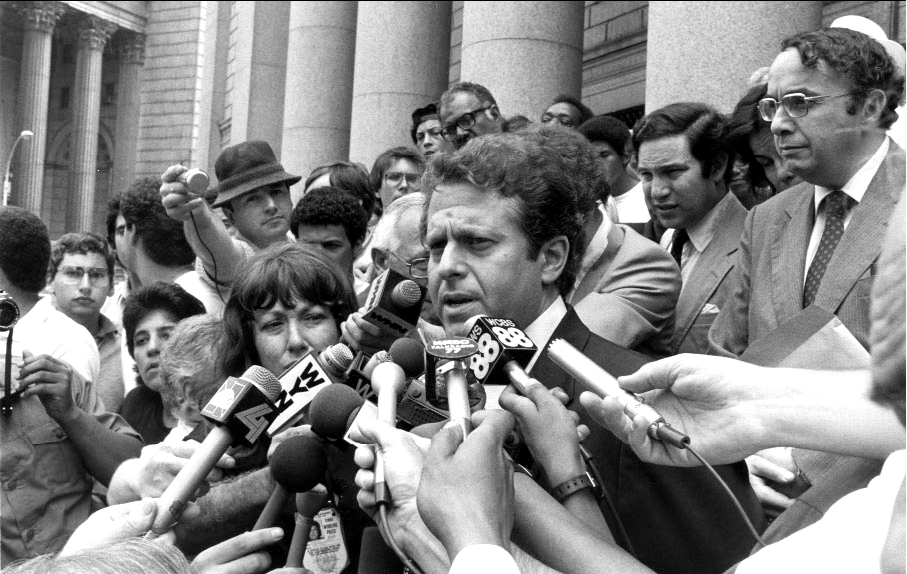
Harvard Law scholar Lawrence Tribe speaking on Rev. Moon’s court proceedings at the Federal Court House in New York
On March 10, 1982, Rev. Moon’s counsel "moved for a bench trial on the ground that pervasive public hostility precluded selection of a fair and impartial jury. However, the government refused to consent, giving as its reason Rev. Moon’s post-arraignment speech at the Foley Square courthouse, published in the New York Times, which criticized the government’s motives for prosecuting him. In his remarks, Rev. Moon suggested that the prosecution was motivated by racial and religious prejudice. As he put it in a memorable turn of phrase, "If my skin were white and my religion Presbyterian, I would not be here today." The government asserted that a jury trial was necessary lest Rev. Moon "blame any adverse result...on religious and racial bigotry." However, defense attorneys argued in their Appellant Brief that "the government in substance and effect punished him for exercising his rights to freedom of expression."
Despite his stated belief that a non-jury trial would have been "fairer," the trial judge sided with the government and refused Rev. Moon’s motion for a bench trial. In attempting to get an "untainted" jury, the judge frankly recognized that "the leaning has been heavily towards people who don’t read much, don’t talk much and don’t know much because they are obviously the persons who start off with the least bias...the less educated and less intelligent people." The downside of this was the jury had trouble comprehending the case, a situation that the government exploited by introducing a great deal of evidentiary complexity and over 2,000 documentary exhibits. The defense contended that the selection process had not produced a jury cleansed of prejudicial attitudes but quite the contrary, one that "was saturated with negative information." Moreover, "the selection of an unusually uneducated and uninformed jury," according to Rev. Moon’s lawyers, "increased the risk that the jury would substitute prejudice for reasoned judgment, denying a fair trial."
There were additional procedural problems. The major one was the assumption on the part of the trial judge that "religious issues would not enter into the case." This was compatible with the government’s intention to treat Rev. Moon no differently than any other corporate executive. However, it skewed the whole proceeding. Rev. Moon’s counsel "contended both pre- and post-trial that his prosecution had been motivated by hostility to his religion." Specifically, they showed that shortly before the IRS began to investigate him, Senator Dole had written to the commissioner of the Internal Revenue urging that a tax investigation be targeted at the Unification Church because the Senator suspected "mind control and indoctrination" rather than the pursuit of "religious faith," viewed the church’s faith as involving "political purposes," and regarded the Church’s founder as leading a "far more affluent life" than he thought appropriate for a "clergyman." Nevertheless, the trial judge denied motions for discovery of selective prosecution. Rev. Moon’s counsel also showed that officials and ministers of other churches engaged in comparable conduct without being prosecuted. Again, the judge "flatly denied even the most minimal discovery on this claim." In addition to these problems, Rev. Moon was refused the interpreter of his choice. On more technical grounds, the defense lawyers contended that the trial court’s instructions to the jury were "fatally defective." Finally, the trial judge cut off inquiry into improper influences on the jury and issued a "sweepingly broad gag order" restraining the defense, "on pain of contempt, from communicating with or contacting in any manner whatsoever any...juror involved in the case without the prior consent of the court."
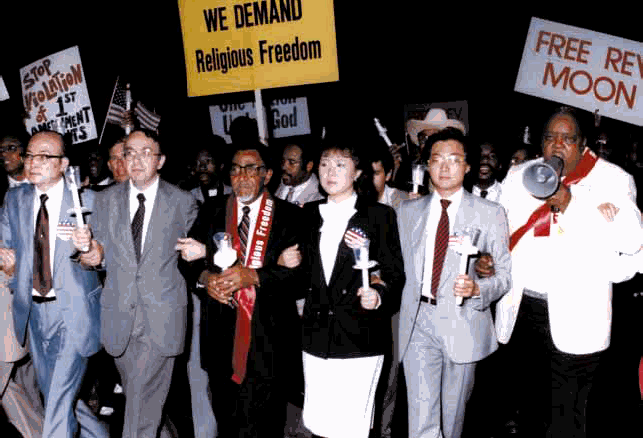
On the march for religious freedom: (from left) Dr. Bo Hi Pak, Dr. Mose Durst, Dr. Joseph Lowery, In Jin and Jin Sung Moon, unknown.
The trial began on April 1, 1981 and lasted approximately six weeks. On May 18, 1981, the jury returned its verdict against Rev. Moon on all charges: one count of conspiracy to file false income tax returns and obstruction of justice and three counts of filing false tax returns for 1973, 1974 and 1975. On July 16, 1981, the court sentenced Rev. Moon to 18 months in prison and a $25,000 fine plus costs. Rev. Moon’s legal team exhausted virtually every appeal motion available. However, in the end, their post-trial motions were all denied. The trial judge denied motions for acquittal, a new trial, and an evidentiary hearing on selective prosecution. The Second Circuit Court of Appeals, in a split decision, sustained the conviction in September 1983 and refused an en banc review by the entire Second Circuit. The U.S. Solicitor General recommended against Supreme Court review and on May 14, 1984, the Supreme Court justices denied Rev. Moon’s petition for certiorari. The defense’s plea for community service instead of time in jail due to fears for Rev. Moon’s security also was refused. The only positive outcome was the trial judge’s "binding recommendation" to the U.S. Attorney General against deportation. Because the court had sentenced him to more than a year in prison, Rev. Moon was eligible for deportation. The government’s lawyers, according to Carleton Sherwood, were "eager to rid the country of Moon" and pressed the judge not to issue an opinion on the matter, "leaving the Immigration and Naturalization Service a free hand to carry out its will." However, in this instance, Judge Gerard Goettel did not see things the government’s way. Some had expressed the view that deportation was the government’s goal all along and that Rev. Moon’s indictment originally was handed down while he was out of the country with the expectation that he would not return and face the charges. Judge Goettel’s position was that deportation, in addition to the eighteen-month jail sentence that he himself had imposed represented "excessive punishment." His decision, though technically a recommendation, was binding on the Justice Department and could not be appealed.
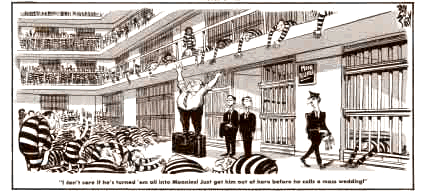
This cartoon appeared in the New York Post on Friday, July 5, 1985. © The New York Post
The final phase of Rev. Moon’s "Danbury course" was his incarceration, first, from July 20, 1984 until July 4, 1985 at Danbury Federal Correctional Institution, Connecticut, and then from July 4, 1985 until August 20, 1985 at Phoenix House Foundation, Inc., a halfway house in Brooklyn, New York. Rev. Moon served thirteen months of his eighteen-month sentence, getting five months off for good behavior. Danbury was a minimum-security facility for approximately 200 men convicted of "white-collar" crimes. Rev. Moon shared a cubicle with Mr. Kamiyama for four months until the latter’s release in November 1984. The facility had visiting hours on alternate days between 8:30 a.m.-3:30 p.m., and a regular stream of family members, church leaders and official guests visited Rev. Moon. All inmates were required to have jobs, and Rev. Moon performed a variety of menial tasks in the dining room, setting up for breakfast every day, mopping, wiping tables, etc. There were no reported incidents during Rev. Moon’s incarceration. He had exhorted church members to "act responsibly and honorably," specifically requesting that they not come to Danbury without permission. Reportedly, in the beginning many inmates avoided Rev. Moon, "afraid that if they were seen with him or attended religious activities together with him that the other inmates would think that they had become Moonies." Some referred to Rev. Moon as "Full-Moon" and Mr. Kamiyama as "Half-Moon." Others sought out Rev. Moon for counsel. Several fellow prisoners testified to his friendliness and exemplary behavior. Rev. Moon had a parole hearing in October 1984 but was denied by the U.S. Parole Commission on February 20, 1985.
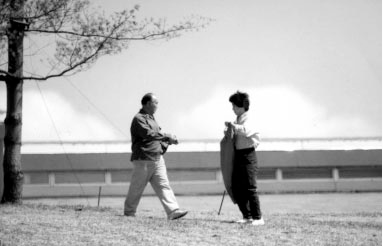
Hyo Jin Moon visits his father at Danbury Correctional Facility.
For his part, Rev. Moon regarded the day of his departure for Danbury as "a glorious and victorious, historical day." In a "Farewell Address" to members, he stated that he was walking "the road of the cross with hope and a totally victorious mind." He exhorted them not to send him off with tears, but that if there were "tears automatically streaming down...they must not be tears of tragedy...but tears of determination, telling me, ‘Trust us. We are going to bring a hundred times greater victory in the days to come.’" He was convinced that "resurrection and Pentecost will come" and that "the Unification sunrise" was "now coming to the world." At Danbury, Rev. Moon spent time praying, reviewing many of his previous speeches, studying English and Spanish, receiving reports and providing direction to church leaders, working with inmates, and reaching out to Christian leaders. Upon his release, Rev. Moon stated at a welcoming "God and Freedom Banquet" in Washington, D.C. that while in prison he "did not brood with hatred or resentment for those who persecuted me, nor did I spend my time...pleading my innocence. Rather, I dedicated the time in prison to prayer and meditation, for understanding what America must do to follow God’s will for the world." Dr. Bo Hi Pak, recently awarded an honorary doctorate from the Catholic University of La Plata, Argentina, found it "providential" that Rev. Moon stayed in a half-way house named "Phoenix House" as there were "two phoenix birds on the Korean president’s flag" and in the West, "the phoenix is a bird that never dies or gives up, but always rises from the ashes, comes back, fights, and wins."
Download entire page and pages related to it in ZIP format
Table of Contents
Information
Tparents Home